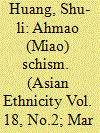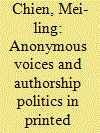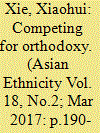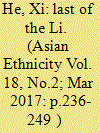|
|
|
Sort Order |
|
|
|
Items / Page
|
|
|
|
|
|
|
| Srl | Item |
| 1 |
ID:
151480


|
|
|
|
|
| Summary/Abstract |
The majority of Ahmao in southwest China have been Christian since a mass conversion movement took place in the 1900s. Throughout the century, Ahmao congregations have gone through several reforms and survived many political campaigns. After two decades of prosperity through China’s reform era, since the 2000s many Ahmao congregations in northern Yunnan have experienced schisms. This paper sets out to investigate a schism that took place in a medium-size Ahmao congregation between 2005 and 2015. Based upon several years of continuous fieldwork, I found that the alleged schism in this Ahmao congregation – rather than describing a long-standing fracture in the community – appears intermittently and should be considered as an effect of religious regulation that problematizes the agency of spiritual practice. Under the regime of religious regulation in contemporary China, Ahmao congregations have been delicately negotiating between different modes of agency as changes in Christian practice become necessary or inevitable.
|
|
|
|
|
|
|
|
|
|
|
|
|
|
|
|
| 2 |
ID:
151479


|
|
|
|
|
| Summary/Abstract |
This paper analyzes two versions of a printed genealogy collated by the Hmub and Kam in Eastern Guizhou, who gave authority to claims of consanguine bonds. It focuses on how the main text of the genealogy and other intertextual practices can either attribute authority to the genealogies or undermine it. On the one hand, elite accounts of ancestors in the genealogies invent a strong ideology of consanguinity that directly contributes to the text’s authority. At the same time, however, the use of Chinese characters to represent the Hmub phonetic system coexists with the Hmub system of patronymy within the assemblage of the individual descendant names. In other words, Chinese characters represent nonpersonal phonetic symbols of the Hmub language. This in turn means that anonymous voices can emerge in other texts. The result is a shift in the nature of authorship from an overtly collective authority to a covertly diffused anonymity.
|
|
|
|
|
|
|
|
|
|
|
|
|
|
|
|
| 3 |
ID:
151478


|
|
|
|
|
| Summary/Abstract |
This paper explores cultural unity and diversity in terms of the origins of orthodoxy. First, it examines the long-standing tradition of territorial kings (tuwang) in the local context – this tradition persisted even under the native chieftain (tusi) system imposed by imperial states. Secondly, it argues that the dual identities of native chieftains reflect competing claims to orthodoxy. Native chieftains derive their legitimacy not only from the state but also from their territory. To root their legitimacy in the territory itself, native chieftains emphasized their ancestors’ heroic events and their own ability as territorial kings to protect the region from invasions by other chieftains as well as the imperial state, while also stressing their ability to provide continued spiritual protection after their deaths. This paper furthermore shows that, in the process of constructing a system of ritual orthopraxy through incorporating state-promoted rituals like ancestor worship, native chieftains gained legitimacy by integrating Tujia society, on the one hand, while expanding their territories along the Western Hunan Miao frontier, on the other hand.
|
|
|
|
|
|
|
|
|
|
|
|
|
|
|
|
| 4 |
ID:
151476


|
|
|
|
|
| Summary/Abstract |
This article investigates the adoption of Daoist ritual among the Yao peoples in South China and mainland Southeast Asia. The Song Dynasty imperial court patronized new Daoist ritual traditions that harnessed martial deities such as the Thunder Gods. Although these traditions were mostly southern in origin, it is not until the Qing dynasty that we find evidence for their circulation among the Yao. After discussing historical representations of Yao religion from the Song to the Qing dynasty and the specific historical contexts that gave rise to each representation, I conclude by examining how beliefs and practices derived from these same Daoist ritual traditions were active among the Iu Mien in Laos during the Second Indochina War. What is needed is an analysis that links a specific ethnographic or historiographic representation with a broader understanding of local, regional, and even transnational ritual practices in the borderlands of China and Southeast Asia.
|
|
|
|
|
|
|
|
|
|
|
|
|
|
|
|
| 5 |
ID:
151481


|
|
|
|
|
| Summary/Abstract |
On Hainan, it is commonly believed that people who identify themselves as Han employ ritual masters (commonly known as daogong 道公) who use texts, while those who view themselves as Li employ the service of geba (no applicable Chinese characters) who do not. This paper argues that the use of Chinese ritual texts implies that the specialist possessing them belongs to a larger religious movement, while those specialists without texts emphasize their own powers as well as those of the masters who instructed them. At the same time, however, my historical and field research indicates that the use of texts has been spreading throughout the Five Finger Mountain region throughout the nineteenth and twentieth centuries, thereby prompting significant changes towards hybrid rituals and the denial of any Li connection. While the ethnic differentiation (minzu shibie 民族識別) campaigns beginning in the 1950s have promoted a sense of ethnic identity, the growing use of written texts indicates that Li ritual practices have been converging with those of the Han.
|
|
|
|
|
|
|
|
|
|
|
|
|
|
|
|
| 6 |
ID:
151477


|
|
|
|
|
| Summary/Abstract |
This article is devoted to establishing, by means of textual and comparative evidence, a link between the religious practitioners called mogong (Zh. bouxmo) and chiefly houses. The mogong are male priests who recite texts in the ‘local’ language, in this case Zhuang or Bouyei. They are also found among other Tai peoples, including the Dai in Yunnan, the Tày and Nùng in Vietnam, and also among other ethnic groups in mainland Southeast Asia. Theirs is a very ancient tradition, dating back possibly 2000 years. Most of the studies on mogong in the PRC have treated the mogong either as an instance of ‘primitive religion’ or as ‘folk beliefs’, and some scholars have declared that the mogong had no connection with politics or government. My argument, based on new evidence from a survey of Zhuang vernacular texts, is that the Zhuang mogong only became village-level vernacular priests after the disbandment of the native chieftaincies, starting in the early eighteenth century, and that before that they were attached directly to chiefly lineages, as they still were in Yunnan and in Southeast Asia until the 1940s. The mogong were responsible for the most important triennial sacrifices to the guardian spirits of the domain.
|
|
|
|
|
|
|
|
|
|
|
|
|
|
|
|
|
|
|
|
|